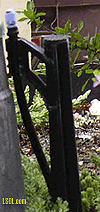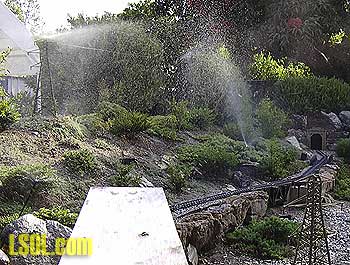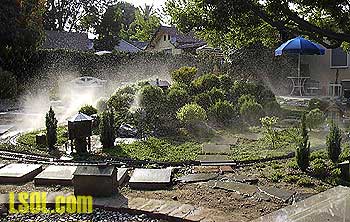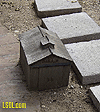Scratch & Bash
:
Accessories
How to use "Power Towers" as sprinklers
Oct 29, 2003


By Dwight Morgan |
Author
Bio
The solution that came to me was drip watering. It works for nurseries so I can make it work for me. Simple enough, right? Wrong.
|
When I started constructing my layout I gave very little thought to how I was going to water the plants. I had sprinklers in place to keep down the dust and water what would eventually be lawn, I thought. I had not considered a railroad when I put in the sprinklers. Now that I have a railroad and lots of trees I needed to figure out how to water them without having a lot of sprinkler heads looking big and out of place among my trains and buildings. The solution that came to me was drip watering. It works for nurseries so I can make it work for me. Simple enough, right? Wrong. I ended up with some drip and a lot of drip parts making spray. After trying several fittings I decided to "standardize on three types of connection to the water pipe in the ground. Main pipes in the ground are 3/4" PVC with 1/2" riser pipes. On top of the risers are either "L" or "T" fittings for 1/2" drip tubing, or 8 position manifolds with individual flow control for each position and 1/4" tubing fittings for the drops. 
TEE Fitting 1/2" | 
TEE Fitting installed | 
L Fitting installed | 
8 position manifold |
Originally the 1/4" tubing came only in black so that is what I have all over my layout. The tubing now comes in colors, which makes it easier to know which flow needs to be adjusted at the manifold. It also is available in soaker hose (not pictured) which I make use of as well.
Four colors of tubing | 
tubing in conduit |
With this improvement I have been able to put 3/4" pipe in the ground, with sweep curves used for electrical wiring, and pull tubing like wire, under sidewalks or locations where sidewalks may be added and keep track of what controls what. Otherwise the only way to know what to adjust at the manifold is trial and error if the tubing is buried as much of mine is. Conventional installation places dripper heads on the ends of the tubing at the base of a plant or splits the tubing with "T" fittings to feed drippers at multiple plants. This does not do much good for the ground covers I hope to have on my layout so I went looking and found that there are spray heads available as well. These can be screwed into holes punched in 1/2" tubing or into the end of 1/4" tubing. 
360 degree, 180 degree and mist sprayers | 
spray head on a spike |
When used with the 1/4" some means of support becomes necessary of course, so there are spikes with clips for this purpose.
Another item I found was a pop-up for the drip systems. It has a 1/4" feeder tube and a cylinder which gets buried in the ground. The head on top can be any of the sprayers since they just thread in. The pop-ups come in 8" and 11" lengths and are just the right size to fill a hole created by pounding a piece of 3/4" schedule 40 PVC into the damp ground and removing it again. 
8" and 11" pop-up devices
With all this material I figured I would be able to water my yard without waste and I would not have to worry about water where I did not want it. What a surprise I had to look forward to. In order to make the water go where I wanted it I used all of these things and still needed more. My model building wife would not allow the placement of pop-up or spike supported spray heads where they would detract from the trains or buildings, unless they were disguised. I designed a pop-up in a piece of 3/4" PVC with antennae on it (think cellular telephone site) and she said that she was not working hard on buildings just to have them blighted by cell sites so that never got installed.
I have placed some pop-ups behind rocks where they can be hidden. Spikes get near plants or other taller items that tend to camouflage them. I also built some of the Aristo Power Tower kits to run power lines on my ridge top. I decided these were the perfect place for spray heads. I ran tubing up one leg, secured by black (UV resistant) zip ties from Panduit.
I have three power towers and one tower to be used as a communication site which are rigged with spray heads. These, in conjunction with some pop-ups and spikes, take care of water for most of my burm. The foliage on the burm is blue mound juniper, sedum and thyme of various varieties for ground cover, and rosemary, miniature pomegranates, and Mexican heather as trees. 
There are two power towers and two pop-ups easily visible in this picture and in the upper right is the communication tower. All are spraying water. The tower in the foreground is not plumbed. The large sheet of plexiglass is the cover for my truss bridge to protect it during persimmon season. It is used about 5 months of the year. Around my Church Hill I have a ring of 1/2" tubing with spray heads installed directly. They are pointed up on about a 60 degree angle to throw the water into the air all around the hill. I hit on this process because, by trial and error.
I found that the prevailing breeze always blew the water away from the hill, no matter where I placed the spray heads. In this configuration I get good coverage no matter which way the breeze blows. The Church Hill has sedum and thyme as ground cover and miniature pomegranate, 
Church Hill curtain of water
Mexican heather, White Swan, rosemary and santolina as trees.
I also have some drippers, controlled by an 8 point manifold, on the pomegranate trees. These drip into 1/2" tubes full of gravel which takes the water down 6 inches. This was my form of deep root watering when I first planted the trees on the hill side. I saw no point in removing it once they were established. This curtain of water is on a separate control valve from the Burm.

Dynamite building | 
8 point manifold exposed | 
ripper on Left green hose |
On the same control as the Church Hill is the 8 point manifold hidden in the Dynamite building. It controls a soaker hose under the thyme between the tracks (R. white hose), a spray head a juniper on the dry river bank (R. green hose), a soaker for plants along the dry river (R. black hose), a pair of drippers for trees near Dew Drop Inn (L. green hose), three drippers for the Blue Oaks N. of the Dew Drop Inn (L. black hose) and three spares, L. white and both brown hoses. Most of this is hard to see even when you are looking. The drip system has really reduced the amount of hand watering I would have to do on the railroad. I have had minimual problems and would recommend you look at installing a drip system on your railroad. Top of Page
|



